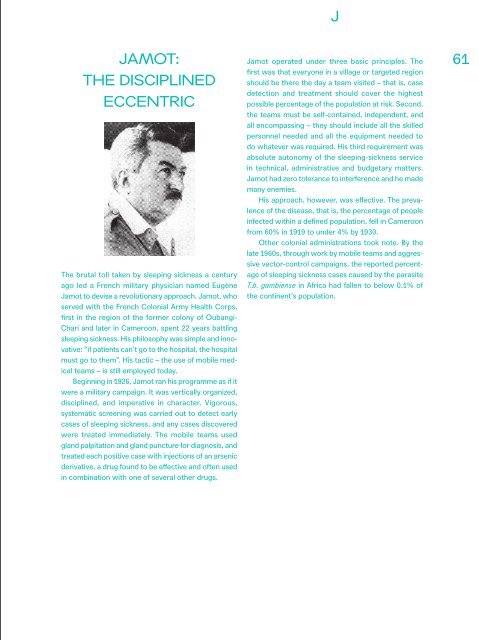Create successful ePaper yourself
Turn your PDF publications into a flip-book with our unique Google optimized e-Paper software.
J<br />
JAMOT:<br />
<strong>THE</strong> DISCIPLINED<br />
ECCENTRIC<br />
The brutal toll taken by sleeping sickness a century<br />
ago led a French military physician named Eugène<br />
Jamot to devise a revolutionary approach. Jamot, who<br />
served with the French Colonial Army Health Corps,<br />
first in the region of the former colony of Oubangi-<br />
Chari and later in Cameroon, spent 22 years battling<br />
sleeping sickness. His philosophy was simple and innovative:<br />
“if patients can’t go to the hospital, the hospital<br />
must go to them”. His tactic – the use of mobile medical<br />
teams – is still employed today.<br />
Beginning in 1926, Jamot ran his programme as if it<br />
were a military campaign. It was vertically organized,<br />
disciplined, and imperative in character. Vigorous,<br />
systematic screening was carried out to detect early<br />
cases of sleeping sickness, and any cases discovered<br />
were treated immediately. The mobile teams used<br />
gland palpitation and gland puncture for diagnosis, and<br />
treated each positive case with injections of an arsenic<br />
derivative, a drug found to be effective and often used<br />
in combination with one of several other drugs.<br />
Jamot operated under three basic principles. The<br />
first was that everyone in a village or targeted region<br />
should be there the day a team visited – that is, case<br />
detection and treatment should cover the highest<br />
possible percentage of the population at risk. Second,<br />
the teams must be self-contained, independent, and<br />
all encompassing – they should include all the skilled<br />
personnel needed and all the equipment needed to<br />
do whatever was required. His third requirement was<br />
absolute autonomy of the sleeping-sickness service<br />
in technical, administrative and budgetary matters.<br />
Jamot had zero tolerance to interference and he made<br />
many enemies.<br />
His approach, however, was effective. The prevalence<br />
of the disease, that is, the percentage of people<br />
infected within a defined population, fell in Cameroon<br />
from 60% in 1919 to under 4% by 1930.<br />
Other colonial administrations took note. By the<br />
late 1960s, through work by mobile teams and aggressive<br />
vector-control campaigns, the reported percentage<br />
of sleeping sickness cases caused by the parasite<br />
T.b. gambiense in Africa had fallen to below 0.1% of<br />
the continent’s population.<br />
61


